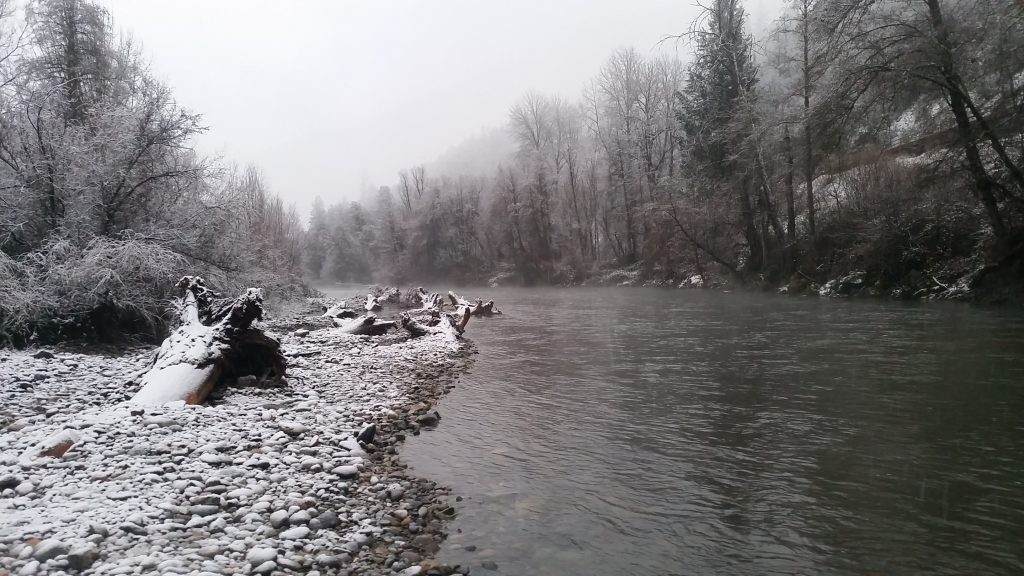REASON FOR ACTION
Dams in rivers block more than just water; sediments are also prevented from passing dams. While the trapping of fine sediments (silt and sand) is generally considered beneficial to fisheries in the Trinity River, trapping of coarse gravels has lead to a deficit in the upper reaches (below the dams). These coarse gravels are a necessary characteristic of spawning beds, so a gravel deficit leads to a reduction in spawning habitats. Gravel is also a mobile material, so is important for maintaining geomorphic processes that lead to a dynamic and diverse river channel.
GRAVEL AUGMENTATION
The TRRP adds gravel to the river to make up for the deficit caused by the dams. The amount gravel injected into the river is based on scientific analyses and calculation of a gravel budget for the river. Gravels injected are of a size appropriate for use by spawning salmon.
Augmentation occurs at several locations in the Trinity River above the confluence of Weaver Creek. Below Weaver Creek, it is thought that tributaries provide sufficient gravel to river processes; gravel may be used at constructed rehabilitation sites for specific purposes, though such gravels generally come from on-site sources such as old dredge-piles. Augmentation may occur during high flow releases or by placement during summer and early fall, typically at rehabilitation sites.
Coarse Sediment
The sediment that makes up the bed and banks of the Trinity River ranges in size from silt and sand to gravel, cobbles and boulders. Since 1964, the dams have trapped all sediment that was normally delivered to the lower river from the upper watershed. Additionally, infrequent high flows of the past few decades have allowed sediment supplied from the tributaries in the first 17 miles below the dams to accumulate in deltas rather than be transported and distributed downstream as historically occurred prior to the TRD. Overall, the changes in the coarse sediment regime have reduced the natural gravel transport processes, reduced gravel bar deposits, and reduced salmon spawning and rearing habitat.
The overall restoration strategy for managing coarse sediment is to increase coarse sediment storage in the river (gravel/cobble bars), improve coarse sediment transport (distribute gravel/cobble downstream), and restore a balance between coarse sediment supply and coarse sediment transport using high flows and mechanical gravel introduction. If the river were considered a conveyor belt periodically transporting and depositing coarse sediment, the proposed restoration strategy would add coarse sediment at the upstream end of the conveyor belt at a rate equal to what the conveyor is moving, such that accumulations or deficits (channel incision and armoring) are minimized. This strategy can be referred to as restoring the coarse sediment budget.
Specific recommendations consist of the following:
- Release flows up to 11,000 cfs to transport and distribute cobbles and gravels from tributary deltas to create bars, riffles, and floodplains in downstream reaches
- Replenish cobble and gravel storage in the reach immediately downstream of Lewiston Dam that is most impacted by the loss of upstream coarse sediment supply
- Introduce long-term periodic gravel and cobble supply in first fifteen miles below Lewiston Dam at a rate equal to that transported by high flow releases to maintain cobble and gravel storage, enabling the river to create and maintain complex instream habitat.
Recommended flow releases will be larger in wetter water years than drier water years. Therefore, larger volumes of cobble and gravel will need to be introduced immediately downstream of Lewiston Dam during wetter years. Actual introduction rates for a given year would be based on sediment transport estimates specific for the high flow releases for that year.
See also New Sites Proposed for 2023.
RESTORATION PAGES
Science and Adaptive Management


